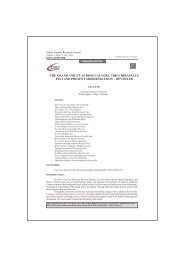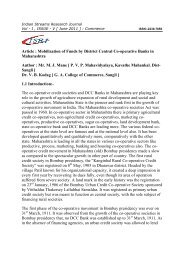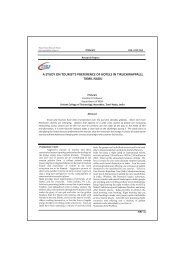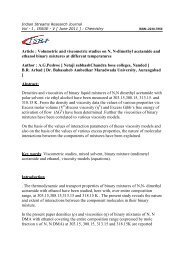An Exploratory Study On The Effects Of Hypnosis - Indian Streams ...
An Exploratory Study On The Effects Of Hypnosis - Indian Streams ...
An Exploratory Study On The Effects Of Hypnosis - Indian Streams ...
- No tags were found...
Create successful ePaper yourself
Turn your PDF publications into a flip-book with our unique Google optimized e-Paper software.
<strong>Indian</strong> <strong>Streams</strong> Research JournalVolume 2, Issue. 7, Aug 2012ISSN:-2230-7850ORIGINAL ARTICLEAvailable online at www.isrj.net<strong>An</strong> <strong>Exploratory</strong> <strong>Study</strong> <strong>On</strong> <strong>The</strong> <strong>Effects</strong> <strong>Of</strong> <strong>Hypnosis</strong> <strong>On</strong> <strong>The</strong>Subjective Well Being <strong>Of</strong> Post Graduate Students In Bangalore1 2Ketan Jaltare <strong>An</strong>d Jini K Gopinath1Post Graduate Student in Counselling, Christ University, Bangalore.2Asst. Professor, Dept. of Psychology, Christ University, Bangalore.Email:Jinikgopinath@gmail.comAbstract:<strong>The</strong> present study attempted to explore the effect of hypnosis on the SubjectiveWell-Being of Post-Graduate students in Bangalore. <strong>The</strong> study was conducted on 5 postgraduatestudents (21-25 years.) who are currently pursuing their education inBangalore. <strong>The</strong> study was based on a pre-test post-test model. First, a semi-structuredinterview was conducted, aimed at assessing the level of Subjective Well-Being of theparticipant, followed by two session of hypnosis over a period of two weeks (one sessionper week). <strong>The</strong> hypnosis sessions were directed at increasing the Subjective Well-Beingof the participants. This was then followed by another semi-structured interview whichwas intended to see if there was any significant change in the perceived level ofSubjective Well-Being. <strong>The</strong> Subjective Well-Being was defined as constituting of 6components, which are Self-acceptance, Positive relations with others, Autonomy,Environmental- Mastery, Purpose in Life, Personal Growth.<strong>The</strong> pre and post interviews were recorded and transcribed, after which a thematic analysis of wasconducted to see if there in any significant change in the themes that emerged, before and after theintervention was administered. <strong>The</strong> results showed that there was a significant increase in the level ofSubjective Well-Being (in almost all the dimensions) after the interventions. <strong>The</strong> nature of this change wasthen analysed and discussed in detail.KEYWORDS:Subjective Well-Being, hypnosisINTRODUCTION:Traditionally hypnosis has been viewed as an altered state of consciousness or trance, perhapssimilar to sleep (Wagstaff, Grahm, 1997). But hypnosis is not sleep. In an operational sense, hypnosis is aresponse to a signal from another, or to an inner signal which activates a capacity for a shift of awareness inthe subject and permits a more intensive concentration upon a designated goal direction (<strong>An</strong>and et. Al,1961). This is an altered state of conscious in which the client can experience extremely vivid mentalimagery. In this state, time may seem to pass more slowly or more quickly than usual, and the individualoften notices things that are passing through their mind that they might not otherwise notice. <strong>The</strong> individualmight also find that he/she is able to ignore certain painful or unpleasant experiences, including even1 2Please cite this Article as : Ketan Jaltare <strong>An</strong>d Jini K Gopinath , <strong>An</strong> <strong>Exploratory</strong> <strong>Study</strong> <strong>On</strong> <strong>The</strong> <strong>Effects</strong> <strong>Of</strong> <strong>Hypnosis</strong> <strong>On</strong><strong>The</strong> Subjective Well Being <strong>Of</strong> Post Graduate Students In Bangalore : <strong>Indian</strong> <strong>Streams</strong> Research Journal (Aug. ; 2012)
<strong>An</strong> <strong>Exploratory</strong> <strong>Study</strong> <strong>On</strong> <strong>The</strong> <strong>Effects</strong> <strong>Of</strong> <strong>Hypnosis</strong> <strong>On</strong> <strong>The</strong> Subjective........2physical pain.<strong>The</strong> concept of hypnosis is something that was spoken about and practiced in many orientalphilosophies and traditions. James Braid, was one of the first people to recognize this. In his work, he drawsanalogies between his own practice of hypnotism and various forms of Hindu yoga meditation and otherancient spiritual practices. Historically, hypnosis was used by many healers, Shamans, Witchdoctors, andother traditional healers, and it is still used today, by psychologists, psychiatrists, dentists, surgeons, andmany other medical professionals. Healing practices that used the same principle and techniques existedeven before the term hypnosis was coined. In ancient India, yogis and sages were more interested inunderstanding an individual's inner experience rather than the external world. Vedic thinkers were morefocused on the order of the inner world rather than with the order of the outer world. <strong>The</strong>y recognized theconnection between rhythmic breathing and mental imagery (Copelan, 2003). Way back in 200 BC, theyoga sutras of Patanjali prescribed eight steps called 'Astangas' of yoga, the last of which is called Samadhior transcendental meditation. This state is akin to Yoga Nidra, a sleep like state where the person is still fullyconscious with total awareness. In this state of conscious deep sleep, one experiences relaxation of both themind and the body.<strong>The</strong> concept of <strong>Hypnosis</strong> as we know it today can be traced back to Franz <strong>An</strong>ton Mesmer(1734-1815), an Austrian physician who gave us what he called '<strong>An</strong>imal Magnetism'. Since then, many studieshave been conducted trying to understand the mechanisms that underlie this phenomenon we now know as<strong>Hypnosis</strong>. <strong>The</strong> hypnotic trance is usually understood as an altered state of consciousness which can beinduced through a multitude of techniques. <strong>An</strong>d this altered state of consciousness, or hypnotic trance,opens the gates to the individual's subconscious mind, allowing the hypnotist or the hypnotherapist to bypassall or most of the individuals conscious defences. <strong>An</strong>d this very virtue is what makes it as effective as itis. However, recently a number of psychologists have questioned this view. Non-state theorists have arguedthat hypnosis can be adequately explained in terms of more ordinary psychological processes such as roleenactment, imagination, relaxation, compliance, obedience, attention, distraction, and attitudes andexpectations, without the necessity of invoking the concept of a special state (Wagstaff, Grahm, 1997). Thisis just one of the many theories of the nature and mechanism of the hypnotic phenomenon that have sprungup over the years.SUBJECTIVE WELL-BEING:Subjective well-being is an extremely hard thing to define or standardize owing to its sheer complexity andinterdependence on various other factors. <strong>The</strong> number of variables that have an impact of subjective wellbeingof an individual are innumerable. <strong>The</strong>se factors could include physiological, genetic, physical,environmental, personality, culture, parenting, geographical location, and many more. This makes itextremely difficult to define, and standardize the definition of subjective well-being. In spite of this, therehave been many studies done on exploring the constituents of well-being, and how to measure it. In 1967,Warner Wilson presented a broad review of subjective well-being (SWB) research entitled, "Correlates ofAvowed Happiness." Based on the limited data available at that time, Wilson concluded that the happyperson is a "young, healthy, well educated, well-paid, Extroverted, optimistic, worry-free, religious,married person with high self-esteem, job morale, modest aspirations, of either sex and of a wide range ofintelligence" (Diener et al, 1999). Our understanding of SWB has come a long way since then. <strong>The</strong> focus isless on things like demographic characteristics that correlate with it, and more on understanding theprocesses that underlie happiness. Some of the uncovered correlates and determinants of SWB, classifyingthem in six broad groups, are: (i) personality factors; (ii) contextual and situational factors; (iii)demographic factors; (iv) institutional factors; (v) environmental factors; and (vi) economic factors(Hoorn, 2007). Some Positive Psychologists' contention is that SWB constitutes people's cognitive andaffective evaluations of their lives. Through the study of SWB in Positive Psychology, we have made asubstantial amount of progress in understanding the components of SWB, the importance of adaptationand goals to feelings of well-being, the temperament underpinnings of SWB, and the cultural influences onwell-being.Carol .D. Ryff, in her paper, 'Happiness is Everything, Or Is It? Explorations on the Meaning <strong>Of</strong>Psychological Well-Being', derives 6 aspects of well-being from her study. <strong>The</strong>se are, Self-acceptance,Positive relations with others, Autonomy, Environmental Mastery, Purpose in Life, and Personal Growth.In her study, 321 men and women, divided among young, middle aged, and older adults, rated themselveson these measures along with six instruments prominent in earlier studies (i.e., affect balance, lifesatisfaction, self-esteem, morale, locus of control, depression). Results revealed that positive relations withothers, autonomy, purpose in life, and personal growth were not strongly tied to prior assessment indexes,thereby supporting the claim that key aspects of positive functioning have not been represented in the<strong>Indian</strong> <strong>Streams</strong> Research Journal • Volume 2 Issue 7 • Aug 2012
<strong>An</strong> <strong>Exploratory</strong> <strong>Study</strong> <strong>On</strong> <strong>The</strong> <strong>Effects</strong> <strong>Of</strong> <strong>Hypnosis</strong> <strong>On</strong> <strong>The</strong> Subjective........3empirical arena. Furthermore, age profiles revealed a more differentiated pattern of well-being than isevident in prior research (Ryff, 1989).For the purpose of this study, SWB was defined to constitute these 6 components derived from Ryff'sstudy:Self-acceptancePositive relations with othersAutonomyEnvironmental MasteryPurpose in LifePersonal Growth.Although <strong>Hypnosis</strong> has been used for a long time in the past, for the most part, it has been used tohelp the individual get rid of some kind of illness or an ailment. For instance, in ancient Egypt, priests usedwhat we now know as hypnotic trance or hypnotic sleep, in Sleep Temples to rid the sick of their illness. Inother ancient cultures, Hypnotic trance was induced through various rituals, and was believed to exorciseindividuals who have been possessed by spirits, and force the evil spirit to leave the individual's body. Evenduring the early 1800s, when Mesmer first introduced the western world to the concept of a trance, whicheventually evolved into the hypnotic trance as we know it today, both animal magnetism and hypnosis wereused only as remedial techniques to cure the ill. This study explored the efficacy of hypnosis when used inthe Positive Psychology paradigm, in trying to enhance the subjective well-being of an individual.OVERVIEW OF THE STUDY:Aim<strong>The</strong> aim of the study was to explore the extent and the nature of the effect of hypnosis on theSubjective well-being of Post-Graduate students in Bangalore.DATA COLLECTION AND METHODOLOGYPurposive sampling was used, through which a sample of 5 post-graduate students in Bangalorewere selected. <strong>The</strong> sample included both, male as well as female students.<strong>The</strong> method of data analysis was <strong>The</strong>matic <strong>An</strong>alysis. Through its theoretical freedom, thematicanalysis provides a flexible and useful research tool, which can potentially provide a rich and detailed, yetcomplex, account of data (Braun and Clarke, 2006). <strong>The</strong>matic analysis is a method for identifying,analysing and reporting patterns (themes) within data (Braun and Clarke, 2006). It is a widely usedtechnique, but there is no clear agreement about what thematic analysis is and how you go about doing it.A semi-structured interview with the participants was conducted. <strong>The</strong> time limit and the exactnature and content of the questions were flexible. Participants were briefed about the purpose of the study,its duration and procedure. <strong>The</strong>y were also assured that decision to participate in the study is entirelyvoluntary and they can withdraw at any time. Informed consent was obtained from each participant using aconsent form. Participants were asked questions pertaining to each of the six components of Subjectivewell-being. Interviews were recorded and subsequently transcribed for further thematic analysis.<strong>The</strong> participants were then subjected to two sessions of hypnotherapy, over a period of 2 weeks(one session per week). <strong>The</strong> sessions were aimed at enhancing the Subjective well-being of the participants,on account of each of the following six components of SWB:Self-acceptancePositive relations with othersAutonomyEnvironmental MasteryPurpose in LifePersonal Growth.<strong>The</strong> hypnosis sessions were administered by a trained and certified hypnotherapist, and thesuggestions given to the participants by the hypnotherapist during the hypnosis sessions revolved aroundthe same components of wellbeing for all the 5 participants.<strong>Indian</strong> <strong>Streams</strong> Research Journal • Volume 2 Issue 7 • Aug 2012
<strong>An</strong> <strong>Exploratory</strong> <strong>Study</strong> <strong>On</strong> <strong>The</strong> <strong>Effects</strong> <strong>Of</strong> <strong>Hypnosis</strong> <strong>On</strong> <strong>The</strong> Subjective........4At the end of the 2 week period, once the intervention was administered, the same process of interviewing,recording and transcribing of the content of the interview, as was done before the intervention wasadministered, was repeated, and the data was analysed using <strong>The</strong>matic <strong>An</strong>alysis.<strong>The</strong> population being studied constituted both male and female, English speaking, post-graduatestudents, from middle to high SES, in Bangalore. Purposive sampling was used, through which a sample of5 post-graduate students, in Bangalore, were picked. <strong>The</strong> sample included both male and female students,as there is no appreciable gender difference in hypnotisability (Weitzenhoffer and Weitzenhoffer, 1958).<strong>The</strong> pre/post intervention interviews were conducted indoors, at a place, depending on theconvenience of the participants as well as the researcher. <strong>The</strong> hypnosis sessions were conducted indoors in aquiet environment so that there are minimum disturbances during the course of the session.<strong>The</strong> participants were first given a briefing as to what the study is about and what exactly their rolewill be. <strong>On</strong>ce the participants were given all the relevant information, the participants signed a consent formprior to the commencement of the interview. A semi-structured interview was first conducted with each ofthe five participants, which was aimed at assessing the SWB of the participants. <strong>The</strong> questions that wereasked during the interview were cantered around each of the six components of SWB as set out herein forthe sake of the current study. <strong>On</strong>ce the first interview was conducted, the participants were subjected to twosessions of hypnosis, which were aimed at enhancing the SWB of the participants. <strong>The</strong> sessions wereconducted over a period of two weeks, and one session was conducted per week. <strong>The</strong> suggestions that weregiven during the sessions were centred on each of the six components of SWB. <strong>The</strong> suggestions were alsospecific and tailored as per the needs of each of the five participants, and were changed based on thefeedback given to the hypnotherapist, by the participants, as the session progressed. <strong>The</strong>re were nostandardized suggestions used. This was done because the hypnosis sessions were interactive, where thetherapist is constantly interacting with the participant, and thus receiving feedback. This allowed thetherapist to modify the suggestions as and when required, as the session progressed. Although thesuggestions were not standardized, the hypnosis sessions were structured.<strong>The</strong> sessions first started with induction of trance, followed by trance deepening, and once thetrance was adequately deep, the next stage was the process of SWB enhancement, and the final stage of thesession was the termination of the session. This process was followed for all the hypnosis sessions, for allthe participants. <strong>On</strong>ce both the hypnosis sessions were administered, the second interview was conducted.<strong>The</strong> second interview also followed the same procedure as the first. Both the interviews were recorded andtranscribed.<strong>The</strong> data analysis was aimed at identifying the main themes in the participant's narratives thatindicated the participant's level of SWB in each of the components of Subjective wellbeing that have beenset out herein for the purpose of this study. <strong>The</strong> transcripts of the pre-intervention interviews of each of the 5participants were analysed first. <strong>On</strong>ce this first set of transcripts were analysed, the second set (postintervention) of transcripts were analysed. Each transcript was analysed in the following way: the transcriptwas read multiple times so the researcher gets familiarized with the transcripts and after several readings,themes which were suggestive of the participant's level of well-being were extracted from the transcripts.Each transcript was analysed in the same way. <strong>On</strong>ce all the transcripts were fully analysed, the themes thatemerged out of the pre-intervention interview for all the participants under each of the components of SWB,were compared to the corresponding themes of the post-intervention interview, and the changes in thethemes that indicated an increase in the participant's level of SWB were analysed and discussed.RESULTS AND DISCUSSION:<strong>The</strong>re was a significant amount of positive change that was identified in almost all the sixcomponents of SWB for all of the participants, as discussed above. <strong>The</strong>se changes were observed after theadministration of two hypnosis sessions aimed at increasing the SWB of the participants, over a period oftwo weeks.Participant 1 showed a significant change in the areas of Self-Acceptance, Relationships,Environmental Mastery and Personal growth. In the area of Self-Acceptance, the participant showed anenhanced sense of comfort with the self, and also a shift from feeling uncertain to feeling a sense ofintegration of the participant's past and her present. In the area of Relationships, the participant reported anincreased feeling of acceptance of others, and a move from reacting aggressively to reacting assertively topeople around her (Williamson and <strong>An</strong>n, 2010). In the area of environmental mastery, the participantreported an increased sense of control and calmness. In the area of personal growth, the participant reportedan increased experience of change and the realization of that change, and also reported a shift from feelingconfused to feeling a sense of control over her own personal growth.Participant 2 showed a significant change in the areas of Self-Acceptance, Relationships, and<strong>Indian</strong> <strong>Streams</strong> Research Journal • Volume 2 Issue 7 • Aug 2012
<strong>An</strong> <strong>Exploratory</strong> <strong>Study</strong> <strong>On</strong> <strong>The</strong> <strong>Effects</strong> <strong>Of</strong> <strong>Hypnosis</strong> <strong>On</strong> <strong>The</strong> Subjective........5Environmental Mastery. In the area of Self-Acceptance, the participant reported an increased sense ofchange and progress, and an increased sense of change. In the area of Relationships, the participant reportedan increased sense of realization and surprize. <strong>An</strong>d the themes that emerged in the area of EnvironmentalMastery were Control and realization (Gardner, 1976).Participant 3 showed a significant change in all the areas except the area of Autonomy. In the areaof Self-Acceptance, the participant reported a sense of increased self-awareness and control, which was notreflected in the first interview. <strong>The</strong> participant also reported an increased sense of positivity (Lynn et al,2006). In the area of Relationships, the participant reported an increased feeling of empathy and even afeeling of security and Surety. In the area of Environmental Mastery, the participant reported an increasedsense of control over self and an increased level of acceptance of the environment. <strong>The</strong> participant alsoshowed a significant change in the themes in the areas of Purpose of Life and Personal Growth. <strong>The</strong> mainthemes that emerged in these areas in the second interview were: an increased sense of Control and Suretyin the area of Purpose of Life, and an increased sense of Change and a sense of Wonder and Excitement inthe area of Personal growth.Participant 4 reported a significant change in the areas of Self-Acceptance, Relationships,Environmental Mastery, Purpose of Life, and Personal Growth. In the area of Self-Acceptance, theparticipant reported an increased sense of Self-Acceptance and self-Awareness. In the area ofRelationships, the participant reported an increased sense of Boldness and a sense of being Non-Judgemental. In the area of Environmental-Mastery, the participant moved from feeling a lack of controland distress before the intervention was administered, to a sense of Control and Discretion after theintervention was administered. In the area of Purpose of Life, the participant reported an increased sense ofPurpose and awareness in the second interview, as opposed to a vague sense of purpose as reported in thefirst interview. In the area of Personal growth, the significant change that was observed was an increasedsense of Hope (Ruysschaert and nicole, 2009).Participant 5 reported a significant change in the areas of Self-Acceptance, Relationships,Autonomy, and Purpose of Life. In the area of Self-Acceptance, the participant moved from feeling a senseof Inadequacy and Uncertainty, to an increase in Self-Acceptance, and acknowledging the fact that there isalways room for Growth. In the area of Relationships, the participant reported in the first interview that he isvery Selective when it comes to making friends, and that he is extremely cautious in doing so. In the secondinterview, the participant reported that he felt a sense of Surety and an increased sense of Altruism towardshumanity in general. In the area of Autonomy, the participant moved from feeling extremely emotionallydependant, to rating himself, by his own standards, as being approximately 70% emotionally independent.In the area of Purpose of Life, the participant reported a sense of uncertainty, self-Precedence andimportance of family in the first interview. In the second interview, the participant reported a sense of peaceand also a feeling that he should use his life to do something for the greater good of humanity, and not onlyhimself (Williamson and <strong>An</strong>n, 2010).In order to minimize the possibility that these changes were brought about by variables other thanthe hypnosis sessions, the participants were asked whether they had experienced any major life events in thepast two weeks, that could be responsible for or that might have contributed to the changes that wereobserved. All participants reported that they had experienced no such life events during the course of thetwo weeks when the study was conducted, with one exception; Participant 2 reported that during the firstweek, after the first hypnosis session had been administered, he had a conversation with a friend about hisabout her father's death. This event, and its impact on the participant, has been discussed and accounted forin the data analysis.<strong>The</strong> results that have been achieved through the two sessions of hypnosis are quite significant anddrastic. Changes have been observed even in components of wellbeing as profound as the purpose of anindividual's life, an individual's conception of personal growth, one's attitude towards relationships withothers, one's level of self-acceptance, and even one's notion of how autonomous one is and the amount ofcontrol one has over one's environment. Such changes are extremely difficult to bring about, within thespan of two weeks, and it is possible that these changes will slowly ware off over a period of time. <strong>On</strong>efactor that could be responsible for the results that have been achieved could be that the second interviewwas conducted between 24 to 48 hours after the second hypnosis session was administered. It is likely thatthe effects that have been observed will slowly reduce as the participant settles back into his/her dailyroutine, and is exposed to all the stressors that he /she normally faces in his/her daily life.SUMMARY AND CONCLUSION:<strong>Hypnosis</strong> has long been used as a therapeutic technique in curing many kinds of illnesses of thebody as well as of the mind. Healing practices that used the same principle and techniques existed even<strong>Indian</strong> <strong>Streams</strong> Research Journal • Volume 2 Issue 7 • Aug 2012
<strong>An</strong> <strong>Exploratory</strong> <strong>Study</strong> <strong>On</strong> <strong>The</strong> <strong>Effects</strong> <strong>Of</strong> <strong>Hypnosis</strong> <strong>On</strong> <strong>The</strong> Subjective........6before the term hypnosis was coined. <strong>An</strong>d before such a time, this hypnotic state used to be called a trancelike or a sleep like state. <strong>The</strong>se traditional healing techniques have been seen in many ancient cultures allacross the world. Right from ancient Egypt, where sleep temples were used as healing centres for peoplewith mental sickness, to oriental philosophies, Vedic practices, and Yoga, the hypnotic trance was known topeoples in one form or another. But in all these cultures, and even most of contemporary hypnotic practices,hypnosis is used as a remedial measure rather than as a preventive or even a life enhancing measure.<strong>The</strong> aim of the present study was to explore the effect of hypnosis on the Subjective Well-Being(SWB) of post graduate students in Bangalore. <strong>The</strong> sample consisted of 5 post-graduate students fromBangalore, who were selected through purposive sampling which included both male as well as femalestudents. <strong>The</strong> study explored not only whether or not there was any effect of hypnosis on the SWB of theparticipants, but also to understand the qualitative nature of this change. Two semi-structured interviewswere conducted, one before the intervention was administered to the participants, and one after theintervention was administered. <strong>The</strong> intervention constituted of two hypnosis sessions conducted over aperiod of two weeks (one per week), aimed at enhancing the SWB of the participants. <strong>The</strong> interviewsconducted were aimed at assessing the SWB of the participants based on six components: Self-acceptance,Positive relations with others, Autonomy, Environmental Mastery, Purpose in Life and Personal Growth.<strong>The</strong> change in the SWB of the participants was assessed through a thematic analysis of the pre and postinterventioninterviews, and analysing the change in the themes that emerged through the analysis.<strong>The</strong> analysis showed that there was a significant improvement in the SWB of the participants afterthe two hypnosis sessions were administered. A positive change in the SWB of the participants in each ofthe six components was observed. While the findings of this study were consistent with the previousresearch, the changes that were observed were quite drastic and significant, and it remains to be seenwhether or not the changes will be long lasting. In order to monitor the longevity of these changes, a followup interview will be conducted after a period of two months, and analysed, to assess whether or not thechanges have persisted. A further analysis of the main themes that emerged through this study could help usbetter understand precisely the kinds of changes that can be brought about using hypnosis. Further analysisof the kinds of suggestions given during the hypnosis sessions and the corresponding change it inducedcould inform the development of new hypnotic techniques and suggestions aimed at inducing specificchanges in the individual.REFERENCES:Ryff, C.D. (1989). Happiness Is Everything, or Is It? Explorations on the Meaning of Psychological Well-Being.Journal of Personality and Social Psychology., 54, 1069- 1081Diener, E. (2009). Subjective Well-Being. Social Indicators Research Series.37, 11-58Diener, E. (2010). Subjective Well-Being. Psychological bulletin. 95, 542-575Diener, E (2010). Subjective Well-Being. Psychological bulletin. 125, 276-302Diener, E (2010). Subjective Well-Being : <strong>The</strong> science of happiness and a proposal for a national index. AmericanPsychologist. 55,34-43Diener, E. & Richard, E. (2010). Well-being: <strong>The</strong> foundations of hedonic psychology. Well-being. <strong>The</strong> foundations ofhedonic psychology.213-229James Horley and J. John Lavery (1994). Subjective Well-Being. Social Indicators Research. 34, 275-282Ross. M, Eyman. A & Kishchuk.N. (1986) determinants of subjective wellbeing. Relative deprivation and socialcomparison. New jersey, library of congress catalogining in publication data.Grom. B. (2000). Religiosity and subjective well-being. 50, 3-4Diener, E (2010). Subjective well-being: <strong>The</strong> science of happiness and a proposal for a national index. AmericanPsychologist, 55, 34- 43Raz. A (2001). A Cross Talk between Clinical and Cognitive Research. <strong>Hypnosis</strong> and Neuroscience, 59,85-90Nash. R. M (2006). Clinical and experimental hypnosis, International Journal of Clinical and Experimental <strong>Hypnosis</strong>,53, 87-93David R. P, Kent A. Q & Barbara J. (2011). Hypnotherapy as an Adjunct to Narcotic <strong>An</strong>algesia for the Treatment of Painfor Burn Debridement. American Journal of Clinical <strong>Hypnosis</strong>, 31, 156-163Faymonville. M.E et al (1997). Psychological approaches during conscious sedation. <strong>Hypnosis</strong> versus stress reducingstrategies: a prospective randomized study. Pain, 73, 361-367Lynn. S. J (2006). Mindfulness, Acceptance, and <strong>Hypnosis</strong>: Cognitive and Clinical Perspectives. International Journalof Clinical and Experimental <strong>Hypnosis</strong>, 54<strong>Indian</strong> <strong>Streams</strong> Research Journal • Volume 2 Issue 7 • Aug 2012
















